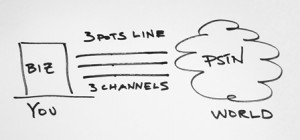
Business Phone Systems 101
How do business phone systems work? This is a very high level introduction to business phone systems aimed at conveying the right message to business
There are many reasons why a business might decide to set up, deploy and manage their own business VoIP phone system (or PBX). Obviously, with costs, ongoing costs are one main reason. Other reasons I hear about include, but are not limited to:
But ultimately, these systems make increased efficiency possible and enable a business to grow on any scale without affecting communication or functionality.
Digital receptionists, extensions, company directories, routing of calls and managing customers are all options with the business phone system. There are two typical deployments of the system: a hosted or virtual system and the self-managed hosted version. There are specific benefits that come from using each.
Which system will work best for you will depend very much upon your business, how it works, and what and why you need the design.
To decide which system you wish to install, it is important to know each’s advantages to choose the one that suits you best.
If you choose a virtual PBX system, you will work with a phone system predominantly used in smaller organizations and takes no time to set up. You need an internet connection and a phone to set up this system. Smaller organizations that use the Virtual PBX system are held off-site, but it is held on-site for self-managed, self-hosted PBX systems.
A virtual PBX system, or cloud phone service, is less expensive because the service is shared with other users and customers, as is the equipment that accompanies it. This makes it even more beneficial for smaller businesses with smaller budgets.
There are two main pricing models for current virtual PBX solutions out there:
With per-minute pricing, a company will pay per usage. Features are bundled together, which can include:
Per-seat pricing depends on the number of employees (or team members) you wish to include in the system. Per-seat pricing is great for companies looking for fixed, predictable monthly costs. Per-seat pricing is also more favourable for service-type businesses like consulting and legal firms, call centres, and similar organizations.
With either pricing model, if your business should grow and require more users, it is pain-free to add an extension without inuring extra costs.
If you or someone from your team is tech-savvy, the alternative is to install and manage your own VoIP server, a self-hosted system. You can choose between a virtual server on the internet or a server (pc) sitting in your office onsite.
You can easily take advantage of an open-source solution, Asterisk, that will provides all the features that an enterprise phone system offers, like call routing, voice mail, and interactive voice recordings.
Along with the server and software, you will also need a phone number (local or toll-free) connected and routed to your VoIP system. You can obtain a phone number from DID providers that will route all inbound and outbound to and from your server. You can get a list of DID providers here.
With a server and phone numbers, you are all set. From here on in, all you will need to do is program the system to your heart’s desire.
Learning curve can be fairly quick, but a phone system is not a set it and forget it type of office equipment.
Some PBX programming considerations:
All of the above-mentioned is time. With a cloud phone system, you typically forget it as soon as you set it. Not many things change throughout a year, except employees joining or leaving the company. With a hosted phone system, that is simple to change at no extra cost.
It was not long ago, before G-Mail when companies deployed their email server like Exchange. The maintenance cost was high, not to mention the costs of an outage, worst-case scenario, a full replacement and recovery. How long could your business go without your email server and phone system? Once all this is added up, you should expect to pay more than you would with the virtual system, so self-hosted systems are usually more suitable for larger firms with larger budgets.
It is important to note, though, that certain risks are associated with using the virtual system, resulting from the server being located off-site. Hence, the user has no direct control over it. This lack of control increases the risk of security and makes the system’s reliability more of an issue. Equally, there are issues with a self-managed hosted system. Because the server sits onsite, maintenance can be an issue for the organization, which can be quite expensive over time.
Want to learn more about Virtual PBX Systems? Here are some related articles that you may find useful:

How do business phone systems work? This is a very high level introduction to business phone systems aimed at conveying the right message to business

It’s happening! You’ve been thinking about it for a while now and have finally decided to switch to business VoIP. Good news, you are not

There comes a time when you are growing your business when you come to a specific problem or crossroads. Whether it involves hiring staff, looking


We’ll give you an intro to the perfect solution that fits your business. Get started on your journey to fearless growth.